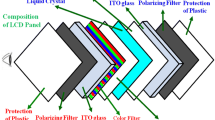Abstract
Disposal of waste CRT glass is now an urgent environmental protection issue. We collected waste CRT glass from monochrome and color television sets, analyzed their chemical compositions using X-ray fluorescence, and studied the leaching characteristics of Pb in the glass using sulfuric and nitric acids and acetic acid buffer leaching toxicity tests. The results showed that the order of the Pb leaching levels was color panel glass < monochrome glass < color funnel glass. The average Pb concentrations leached in sulfuric and nitric acids from color funnel and panel glasses and from monochrome funnel and panel glasses did not exceed the regulatory limits for Pb according to the China Identification Standards for Hazardous Waste—Identification for Extraction Toxicity. Only the average concentration of Pb leached in acetic acid buffer from color funnel glass exceeded the regulatory levels for Pb while those from other glasses were lower than 1 mg/L. Monochrome panel and funnel glasses and color panel glass can be disposed off as common industrial solid waste or co-disposed off with municipal solid waste. Color funnel glass, however, should be managed and disposed off in strict conformity with the requirements for hazardous waste disposal.
Similar content being viewed by others
References
Poon CS (2008) Management of CRT glass from discarded computer monitors and TV sets. Waste Manage 28(9):1499
Yamashita Masaru, Wannagon Anucha, Matsumoto Sachiko (2010) Leaching behavior of CRT funnel glass. J Hazard Mater 184(1–3):58–64
Stephen E, Musson Jang YC, Timothy G, Townsend TG (2000) Characterization of lead leachability from cathode ray tubes using the toxicity characteristic leaching procedure. Environ Sci Technol 34(20):4376–4381
Ling TC, Poon CS, Kou SC (2011) Feasibility of using recycled glass in architectural cement mortar. Cement Concr Compos 33(8):848–854
Chen M, Zhang FS, Zhu JX (2009) Detoxification of cathode ray tube glass by self-propagating process. J Hazard Mater 165(1–3):980–986
Bernardo E, Albertini F (2006) Glass foams from dismantled cathode ray tubes. Ceram Int 32(6):603–608
Matamoros-Veloza Z, Rendón-Angeles JC, Yanagisawa K (2008) Preparation of foamed glasses from CRT TV glass by means of hydrothermal hot-pressing technique. J Eur Ceram Soc 28(4):739–745
Bernardo E, Scarinci G, Hreglich S (2005) Development and mechanical characterization of Al2O3 platelet-reinforced glass matrix composites obtained from glasses coming from dismantled cathode ray tubes. J Eur Ceram Soc 25(9):1541–1550
Andreola F, Barbieri L, Karamanova E (2008) Recycling of CRT panel glass as fluxing agent in the porcelain stoneware tile production. Ceram Int 34(5):1289–1295
Ling TC, Poon CS (2012) A comparative study on the feasible use of recycled beverage and CRT funnel glass as fine aggregate in cement mortar. J Clean Prod 29–30(1):46–52
Miyoshi H, Chen DP, Akai T (2004) A novel process utilizing subcritical water to remove lead from wasted lead silicate glass. Chem Lett 33(1):956–957
Méar F, Yot P, Cambon M, Ribes M (2006) The characterization of waste cathode-ray tube glass. Waste Manage 26(12):1468–1476
Menad N (1999) Cathode ray tube recycling. Resour Conserv Recycl 26(3–4):143–154
Jang YC, Townsend TG (2003) Leaching of lead from computer printed wire boards and cathode ray tubes by Municipal Solid Waste Landfill Leachates. Environ Sci Technol 37(20):4778–4784
Townsend TG, Musson S, Jang YC, Chung IH (1999) Characterization of lead leachability from cathode ray tubes using the toxicity characteristic leaching procedure. In: Report #99-5, Florida center for solid and hazardous waste management. Gainesville, Florida
State environmental protection administration (2007) Solid waste-extraction procedure for leaching toxicity-sulphuric and nitric acid method (HJ/T299-2007). China environmental science press, China
State environmental protection administration (2007) Solid waste-extraction procedure for leaching toxicity-Acetic acid buffer method (HJ/T300-2007). China environmental science press, China
State environmental protection administration (2007) Identification standards for hazardous wastes-Identification for toxic substance content (GB5085.6-2007). China environmental science press, China
State environmental protection administration (2007) Identification standards for hazardous wastes-Identification for extraction procedure toxicity (GB5085.3-2007). China environmental science press, China
US EPA, EPA Office of Solid Waste (1994) Determination of Ground Water Dilution Attenuation Factors
40 CFR 261.24-Toxicity Characteristic. http://www.gpo.gov/fdsys/pkg/CFR-2011-title40-vol26/pdf/CFR-2011-title40-vol26-sec261-24.pdf
40 CFR 261.39(c), Conditional Exclusion for Used, Broken Cathode Ray Tubes (CRTs) and Processed CRT Glass Undergoing Recycling. http://www.epa.gov/wastes/hazard/recycling/electron/
Acknowledgments
This research was supported by the National Natural Science Foundation of China (51178439).
Author information
Authors and Affiliations
Corresponding author
Rights and permissions
About this article
Cite this article
Gao, H., Yang, Y., Huang, Q. et al. Pb-Laden CRT glass as classifying hazardous waste definition or exemption in landfill disposal in China. J Mater Cycles Waste Manag 19, 241–246 (2017). https://doi.org/10.1007/s10163-015-0411-x
Received:
Accepted:
Published:
Issue Date:
DOI: https://doi.org/10.1007/s10163-015-0411-x




